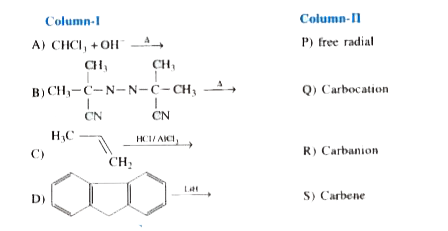The order of -I effect is NO2>CN>SO3H>CHO>CO>COOH > CoCl > COOR > CONH_(2) F>Cl>Br>I>OR>C6H5Solution in Telugu
Step by step video & image solution for The order of -I effect is NO_(2) gt CN gt SO_(3)H gt CHO gt CO gt COOH > CoCl > COOR > CONH_(2) F > Cl > Br > I > OR > C_6 H_(5) by Chemistry experts to help you in doubts & scoring excellent marks in Class 11 exams.
Updated on:21/07/2023Topper's Solved these Questions
- GENERAL ORGANIC CHEMISTRYBOOK - AAKASH SERIESCHAPTER - GENERAL ORGANIC CHEMISTRYEXERCISE - Objective Exercise -1
204 Videos
- GENERAL ORGANIC CHEMISTRYBOOK - AAKASH SERIESCHAPTER - GENERAL ORGANIC CHEMISTRYEXERCISE - Objective Exercise -2
82 Videos
- GENERAL ORGANIC CHEMISTRYBOOK - AAKASH SERIESCHAPTER - GENERAL ORGANIC CHEMISTRYEXERCISE - Subjective Exercise -7
8 Videos
- ENVIRONMENTAL CHEMISTRYBOOK - AAKASH SERIESCHAPTER - ENVIRONMENTAL CHEMISTRYEXERCISE - EXERCISE ON PASSAGE (PASSAGE-III)
5 Videos
- HYDROCARBONSBOOK - AAKASH SERIESCHAPTER - HYDROCARBONSEXERCISE - ADDITIONAL PRACTICE SHEET ( LEVEL-II (PRACTICE SHEET (ADVANCED) (MATRIX MATCHING TYPE QUESTIONS)))
5 Videos
Similar Questions
Urea was prepared first time in the laboratory by heating
View SolutionThe compound containing sp sp2 and sp3 hybridised carbon atoms in 1:2:3 ratio is
View SolutionExplain (a) column chromatography, (b) thin layer chromatography and (c ) partition chromatography
View SolutionOzone layer acts as one of the most important life support system. The major cause of ozone layer destruction is believed to be the release of chlorofluorocarbon compounds. UV radiation causes the chlorofluouocarbons to dissociate : CF2Clhv−−→Cl⋅+CF2CI A highly reactive chlorine atomis responsible for the decomposition of ozone. Cl⋅+O3(g)→ClO⋅+O2(g)ClO⋅+O(g)→Cl⋅+O2(g) Free radicals of chlorine decompose ozone molecules in a chain reaction. The depletion of ozone layer leading to ozone hole has, however, been mainly observed in the stratosphere over Antarctica. Special type of cloud called polar stratospheric colouds are formed over Antarctica.These clouds (contain solid HNO3.3H2O) play an important role in ozone depletion.
ClO⋅+NO2→ClONO2
ClONO2+H2O→HOCl+HNO3
ClONO2+HCl→Cl2+HNO3
HOClhv−−→HO⋅+Cl⋅
The reactive chlorine atoms thus formed are rendered to deplete ozone layer.
The ozone layer is present in :
View SolutionMatch the intermediates formed in the reaction.

View SolutionThe decreasing order of electron affinity of F,Cl and Br is F>Cl>Br.
View SolutionStatement-1 : Rate of electrophilic addition on alkene Higt HBr gt HCI gt HF. Statement-2 : Order of nucleophilicity I^(-) gt Br^(-) gt Cl^(-) gt F^(-).
View Solutionएल्किल समूहों के +I−प्रभाव का क्रम ………….>2∘>……………. होता है।
View Solutionहाइड्रोजन हैलाइडों का द्विध्रुव आघूर्ण का घटता हुआ क्रम है-
H−F>H−CI>H−Br>HI
View SolutionFor which one of the following properties of halogens the sequence F>Cl>Br>I holds good
View SolutionTrans-effect (a kinetic phenomenon) indicates the labilisation at the trans-position during the nucleophilic substitution.
The ligand which can weaken its trans bond more is considered to have its more trans influence. Trans-effect series :
CN−,CO>H−>Ph−>NO−2,I−>Br−>Cl−>NH3>OH−>H2O
[PtCl4]2−NH3−−→2eq.products :
View SolutionTrans-effect (a kinetic phenomenon) indicates the labilisation at the trans-position during the nucleophilic substitution. The ligand which can weaken its trans bond more is considered to have its more trans influence. Trans-effect series : CN^(-),COgtH^(-) gt Ph^(-) gt NO_(2)^(-),I^(-) gt Br^(-) gt Cl^(-) gt NH_(3) gt OH^(-) gt H_(2)O [Pt(NH_(3))_(4)]^(2+) overset(Cl^(-)underset(2eq.) to "products" :
View SolutionThe electron gain enthalpies of halogens decrease in the order F>CI>Br>I. Comment upon the statement
View SolutionHow many of the following orders are correct ?
(a) H–F<H–Cl<H–Br<H–I (Bond length)
(b) H–F<H–Cl<H–Br<H–I (Acidic strength)
(c) H–F<H–Br<H–Cl<H–F (Bond strength)
(d) H–F>H–Cl>H–Br>H–I (thermodynamic stability)
(e) H–F<H–Cl<H–Br<H–I (reducing power)
(f) H–F>H–I>H–Br>H–Cl (Melting Point)
(g) H–F>H–I>H–Br>H–Cl (Boiling point)
View SolutionTrans-effect (a kinetic phenomenon) indicates the labilisation at the trans-position during the nucleophilic substitution.
The ligand which can weaken its trans bond more is considered to have its more trans influence. Trans-effect series :
CN−,CO>H−>Ph−>NO−2,I−>Br−>Cl−>NH3>OH−>H2O
[PtCl4]2−NH3−−→2eq.products :
View Solution
